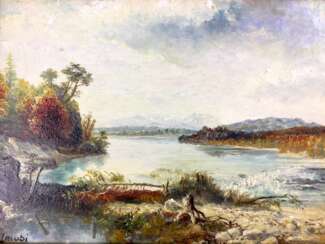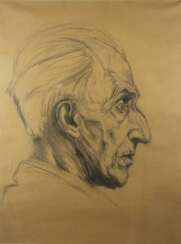color profi

Lyonel Charles Adrian Feininger was an American-German artist renowned for his unique integration of Expressionism, Cubism, and Bauhaus principles. His body of work, which spans several critical decades in modernism's development, is celebrated for its distinctive blend of architectural and nautical motifs, articulated through planar shifts and jagged lines of Cubism, with a vibrant Orphist color palette.
Lyonel Feininger's journey as an artist began in earnest when he was 36, becoming a pivotal figure in various German expressionist groups and a founding member of the Bauhaus, where he led the printmaking workshop. His art, which also includes significant contributions to caricature and photography, explores the intricate relationship between humanity and industrialization, evident in his depictions of architectural and mechanized forms.
His work was subject to Nazi criticism, being labeled as "degenerate," which led to his return to the United States, where he continued to evolve his artistic style. Posthumously, Lyonel Feininger's art has been the focus of several retrospectives, and his pieces, like "Jesuits III," continue to fetch high figures at auctions, underscoring his lasting impact on the art world.
Notably, Lyonel Feininger's "Cathedral" woodcut, representing the Bauhaus's utopian vision, remains one of his most iconic works, symbolizing the integration of art and craftsmanship with its avant-garde yet traditional approach. His legacy is further carried by his sons, Andreas and T. Lux Feininger, who also made their marks in the arts.
For collectors and art and antiques experts, Feininger's work represents a fascinating intersection of various art movements and a testament to the enduring nature of expressive and innovative artistry. To stay updated on new product sales and auction events related to Lyonel Feininger, consider signing up for updates, ensuring you're informed about the latest opportunities to engage with his enduring legacy.




Anton Alexander von Werner, a German painter, was celebrated for his historical paintings that captured key political and military events of Prussia. His works are notable for their depiction of significant moments such as the proclamation of the German Empire at the Hall of Mirrors, Versailles, in 1871. This particular painting marked a turning point in his career, earning him acclaim and establishing his reputation as a leading historical painter of his time.
Von Werner's art was deeply influenced by his experiences during the Franco-Prussian War, where he served in an unofficial capacity alongside the 3rd Army Corps. His firsthand observations of war and its leaders, such as Bismarck and Moltke, enriched his paintings with authenticity and emotional depth.
As the director of the Berlin Academy from 1875 until his death in 1915, Werner played a crucial role in shaping German art education and had the opportunity to tutor German Emperor William II in painting. His works, including commissioned pieces for the Victory Column and other public monuments in Berlin, often utilized innovative techniques such as stained glass mosaics.
For collectors and experts in art and antiques, Werner's paintings are significant not only for their artistic quality but also for their historical portrayal of the Wilhelmine Period in Germany. His works continue to be appreciated in exhibitions and collections globally.
To receive updates on new product sales and auction events related to Anton Alexander von Werner, you can sign up for our newsletter. This will ensure you remain informed about opportunities to acquire works by this pivotal figure in German art history.


Kurt-Hermann Kühn is a German painter and graphic artist. He trained as a decorator and studied from 1946 to 1952 at the Academy of Graphic Arts and Printing in Leipzig and in Berlin at the Academy of Fine and Applied Arts.
Kurt-Hermann Kühn travelled to Syria and Egypt. These journeys are reflected in many of his paintings. In addition to his extensive painting and graphic work, he created many large-format murals, mainly frescoes. His portraits of women and erotic drawings have also attracted much critical attention.

















































































